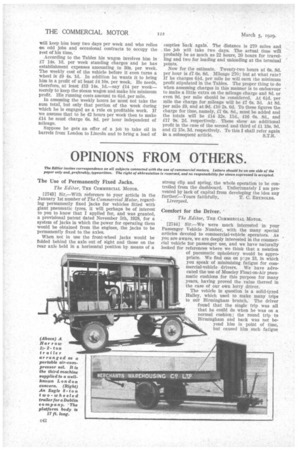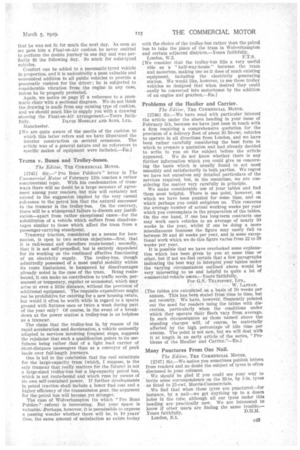OPINIONS FROM OTHERS.
Page 64

Page 65

If you've noticed an error in this article please click here to report it so we can fix it.
The Editor invites correspondence an all subjects connected with the use of commercial motors. Letters should be on one side of the paper only and, preferably, typewritten. The right of abbreviation is reserved, and no responsibility for views expressed is accepted.
The Use of Permanently Fixed Jacks.
The Editor, THE COMMERCIAL MOTOR.
[2743] Sir,—With reference to your article in the January 1st number of The Commercial Motor, regarding permanently fixed jacks for vehicles fitted with giant pneumatic tyres, it will perhaps be of interest to you to know that I applied for, and was granted, a provisional patent dated November 5th, 1928, for a system of jacks in which the power for operating them would be obtained from the engines, the jacks to be permanently fixed to the axles.
When not in use the front-wheel jacks would be folded behind the axle out of sight and those on the rear axle held in a horizontal position by means of a
strong clip and spring, the whole operation to be controlled from the dashboard. Unfortunately I am prevented by lack of capital from developing the idea any
further—Yours faithfully, T. C. REYNOLDS. Liverpool.
Comfort for the Driver. '
The Editor, THE COMMERCIAL MOTOR.
[2744] Sir.—We were much interested in your Passenger Vehicle Number, with the many special articles devoted to commercial-vehicle operators. As you are aware, we are deeply interested in the commercial vehicle for passenger use, and we have naturally looked for references where we think that a mention of pneumatic upholstery would be appropriate. We find one on p-ge 13, in which you speak of minimizing fatigue for commercial-vehicle drivers. We •have advocated the use of Moseley Float-on-Air pneumatic cushions for this purpose for many years, having proved the value thereof in the case of our own lorry driver.
The vehicle in question is a solid-tyred Halley, which used to make many trips to our Birmingham branch. The driver found that the single trip was all that he catild do when he was on a normal cushion; the round trip to Birmingham and back was not beyond him in point of time, but caused him such fatigue
that he was not fit for much the next day. As soon as we gave him a Float-on-Air cushion he never omitted to perform the double journey in one day and was perfectly fit the following day. So much for solid-tyred vehicles.
Comfort can be added to a pneumatic-tyred vehicle in proportion, and it is undoubtedly a most valuable and economical addition to all public vehicles to provide a pneumatic cushion for the driver ; he is subjected to considerable vibration from the engine in any case, unless he be properly protected.
Again, we notice on page 37 a reference to a pneumatic chair with a sectional diagram. We do not think the drawing is made from any existing type of cushion, and we should much like to supply you with a drawing showing the Float-on-Air arrangement.—Yours faith fully, DAVID MOSELEY AND SONS, LTD, Manchester.
[We are quite aware of the merits of the cushion tci which this letter refers and we have illustrated the interior construction on several occasions. The article was of a general nature and no references to specific makes of equipment were included.—En.1
Trams v. Buses and Trolley-buses.
The Editor, THE COMMERCIAL MOTOR.
[2745] Sir,—" Pro Bona Publico's " letter in The Commercial Motor of February 12th touches a rather controversial topic. With his condemnation of tramways there will no doubt be a large measure of agreement among your readers, but this will certainly not extend to the suggestion implied by the very casual reference to the petrol bus that the natural successor to the tramcar is the trolley-bus. On the contrary, there will be a widespread failure to discern any justification—apart from rather exceptional cases—for the substitution of a vehicle which suffers from disadvantages similar to those which affect the tram from a passenger-carrying standpoint.
Tramway traction, considered as a means for locomotion, is open to two serious objections—first, that it is rail-bound and therefore route-bound ; secondly, that it is not self-propelled, but is entirely dependent for its working on the continued effective functioning of an electricity supply. The trolley-bus, though admittedly possessed of a most useful .mobility within its route limitations, is hampered by disadvantages .already noted in the ease of the tram. Being routebound, it can make no contribution to traffic needs, permanent or temporary, regular or occasional, whichmay arise at even a little distance, without the provision of additional equipment. The requisite expenditure might not be prohibitive for catelsing for a new housing estate, but would it often be worth while in regard to a sports ground with fixtures once or twice a week during part of the year only? Of course, in the event of a breakdown at the power station a trolley-bus is as helpless. as a tramcar.
The claim that the trolley-bus is, by reason of its rapid accieleration and deceleration, a vehicle eminently adapted to services involving frequent stops, suggests the rejoinder that such a qualification points to its usefulness being rather that of a light load carrier of short-distance passengers than as a conveyer of peak loads over full-length journeys.
One is led to the conclusion that the real substitute for the large-capacity, tram (which, I suppose, is the only tramcar that really matters fOr the future) is not a large-sized trolley-bus but a big-capacity petrol bus, which is not route-bound and which runs by means of its own self-contained power. If further developments in petrol traction shall include a lower fuel cost and a higher efficiency of the transmission gear, the argument for the petrol bus will become yet stronger. The case of Wolverhampton (to which "Pro Bono Public° " ,refers) is interesting. But your space is valuable. Perhaps, however, it is permiasible to express a passing wonder whether there will be, in 10 years'
t hue,' the same amount of satisfaction as exists to-day with the choice of the trolley-bus rather than the petrol bus to take the place of the tram in Wolverhampton and certain adjacent districts.—Yours faithfully, London, W.3. F. T. S.
[We consider that the trolley-bus fills a very useful role as a "half-way-house" between the tram and motorbus, making use as it does of much existing equipment, including the electricity generating station. We would like, however, to see these trolley vehicles so designed that when desired they could • easily be converted into motorbuses by the addition of an engine and gearbox.—En.]
Problems of the Haulier and Carrier.
Th Editor, THE COMMERCIAL MOTOR.
[2746] Sir,—We have read with particular interest the article under the above heading in your issue of February 5th, because we have just been in touch with a firm requiring a comprehensive quotation for the provision of a delivery fleet of about 30 30-cwt. vehicles to operate in all directions from London, and we have been rather carefully considering the best form in which to prepare a quotation and had already decided to write to you on the subject before the article appeared. We do not know whether there is any further information which you could give us concerning the basis which is usually found to act most smoothly and satisfactorily to both parties. We regret we have not ourselves any detailed particulars of the services required, but, in the meantime, we are considering the matter very carefully in principle.
We make considerable use of your tables and find them most helpful. There is one point, however, on which we have been puzzled for some time, and on which perhaps you could enlighten us. This concerns the average number of actual working weeks per year which you contemplate in the preparation of the tables. On the one hand, if one has long-term contracts one may work one's vehicles to an average of nearly 50 weeks in the year, whilst if one be doing a more miscellaneous business the figure may easily fall to between 30 and 40 weeks per year, and in some exceptional work which we do this figure varies from 22 to 28 weeks per year.
It is possible that we have overlooked some explanation which has been given by you at some time or other, but if not we feel certain that a few paragraphs indicating the best way to interpret your tables under the varying circumstances outlined above would be very interesting to us and helpful to quite a lot of commercial-vehicle Users.—Yourslaithfully, For G.N: TRANSPORT, LTD., W. LAFFAX. [The tables are calculated, on a basis of 50 weeks per annum. This has been stated from time to time, but not recently." We have, howevd, frequently pointed out the need for readers using the tables with discretion, particularly when the conditions under which they operate their fleets vary from average. In such circumstances as those named above the standing charges will, of course, be materially affected by the high percentage of idle time per annum. The point is not new, but we will deal with it at length in an early article of the series, "Problems of the Haulier and Carrier."—En.]
Many Punctures From One Nail.
The Editor, THE COMMERCIAL MOTOR. [2747] Sir,—We notice you sometimes publish letters from readers and no doubt the subject of tyres is often discussed in your. columns. We should be glad if you could see your way to invite some correspondence on the 33-in. by 5-in. tyres . as fitted to 25-cwt. Morris-Commercials.
We find that when these tyres are punctured—for instance, by a nail—we get anything up to a dozen holes in the tube, although all our tyres under this
• heading are practically new. We are interested to know if other users are finding the same trouble.—
Yours faithfully, D.H.M. London, N.1.












































































































